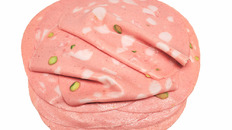Meats and Sausages
Mortadella di Bologna
| Meats | Metric | US |
|---|---|---|
| Pork | 700 g | 1.54 lb |
| Jowls, belly or fat trimmings | 200 g | 0.44 lb |
| Back fat | 100 g | 0.22 lb |
Ingredients per 1000g (1 kg) of meat
| salt | 18 g | 3 tsp |
| cure #1 | 2.5 g | ½ tsp |
| white pepper | 2.0 g | 1 tsp |
| whole peppercorns | 4.0 g | 1 tsp |
| coriander | 0.5 g | ¼ tsp |
| garlic powder | 1.5 g | ½ tsp |
| anise | 1.0 g | ½ tsp |
| mace | 1.0 g | ½ tsp |
| caraway, ground | 0.5 g | ¼ tsp |
| pistachios, whole | 35 g | ¼ cup |
| red wine | 60 ml | ¼ cup |
| cold water | 60 ml | 2 oz fl |
Instructions
- Dice back fat into ¼” cubes for use as show meat.
- Grind all meats through ¼” (6 mm) plate, partially refreeze ground meat and grind again through ⅛” (3 mm) plate.
- Mix ground meats with all ingredients (except whole peppercorns and pistachios).
- Emulsify ground meats in a food processor adding cold water and red wine. (If there i no food processor available, partially refreeze ground meat and grind again through 3 mm plate).
- Mix emulsified meat paste with cubed fat, pistachios and whole peppercorns.
- Stuff into 100 mm (4") fibrous casings.
- Cook in water at 176 °F (80° C) to an internal meat temperature of 154°F (68° C), about 2 hours.
- Cool and refrigerate.
Notes
Mortadella Bologna was awarded PGI certificate of origin on July 18,1988.
Mortadella Bologna PGI is a large, generally oval or cylindrical in shape sausage, made from pork meat, stuffed into natural or synthetic casings and subjected to prolonged cooking. The sausage is not smoked. It exhibits bright pink color and, in the slice, there must be, in a quantity of not less than 15% of the total mass, white squares of fat. It must be noted that almost every country in Europe produces its own versions of mortadella, in some there is no visible fat, in others there are diced bell peppers, stuffed olives or nuts. All those sausages can be called mortadella, however, there is only one Mortadella Bologna PGI which is made in the authorized region of Italy. In some regions mortadella Bologna is simply referred to as Bologna. Mortadella Bologna must be produced in accordance with a much stricter production process-the one used for centuries in the geographical area - than does ordinary mortadella.
The geographical area of production
The area of production comprises the territory of the following Italian regions or provinces: Emilia-Romagna, Piedmont, Lombardy, Veneto, Province of Trento, Marche, Lazio and Tuscany.
History
The name mortadella is said to date back to Ancient Roman times; according to some claims it is derived from mortarium (mortar), such a device being used to crush pig meat, as shown in particular by an engraving on a funeral stone on display at Bologna's Archeological Museum; others, however, claim that the word comes from murtada ("seasoned with myrtle", a plant commonly found in Lazio). Either way, the production of mortadella can be ascribed to an area under Roman influence that extends from Emilia-Romagna to Lazio. It is traditional Bolognese cooking's best-known sausage, with certified historical references dating back to the 16th century. There are also numerous references to the designation in Italian literature in later centuries. More recently, there have been references to the designation in bilateral agreements Italy has signed with France, Germany, Spain and Austria on the protection of indications of provenance, designations of origin and other geographical designations reserved for products originating in Italy.
Production
Meat: high quality pork meat, fat from dewlap/jowls, hard fat. No mechanically separated meat allowed.
Ingredients: salt, whole or crushed pepper, pistachio nuts, sugar <0.5%, sodium nitrite maximum 140 ppm (parts per million), ascorbic acid, sodium ascorbate, aromatic herbs and spices.
Processing: meat must be very finely ground or emulsified; meat particles should not be larger than 0.9 mm (0.03 inch). The show-fat should be briefly scalded, washed, drained and then diced. Emulsified meat, diced fat and all ingredients are mixed together and stuffed into natural or synthetic casings. The sausages are cooked in dry air ovens, for a few hours up to a few days for the largest or giant mortadella until the sausages reaches 70 C internal temperature. Then the sausages are rapidly cooled by cold showering, then left to drain in a cooling chamber. The sausages should reached the internal temperature of <10° C (50° F) as soon as possible.


















